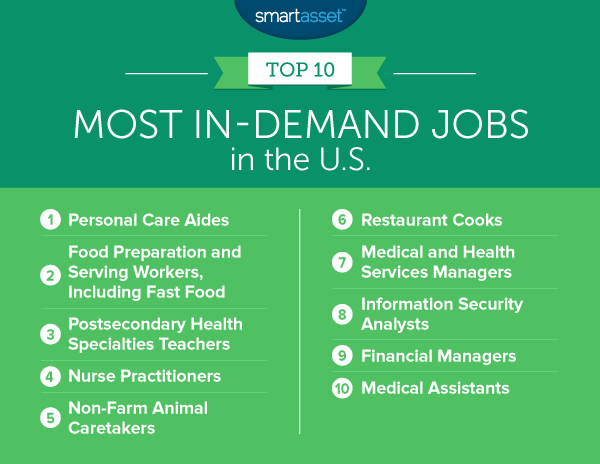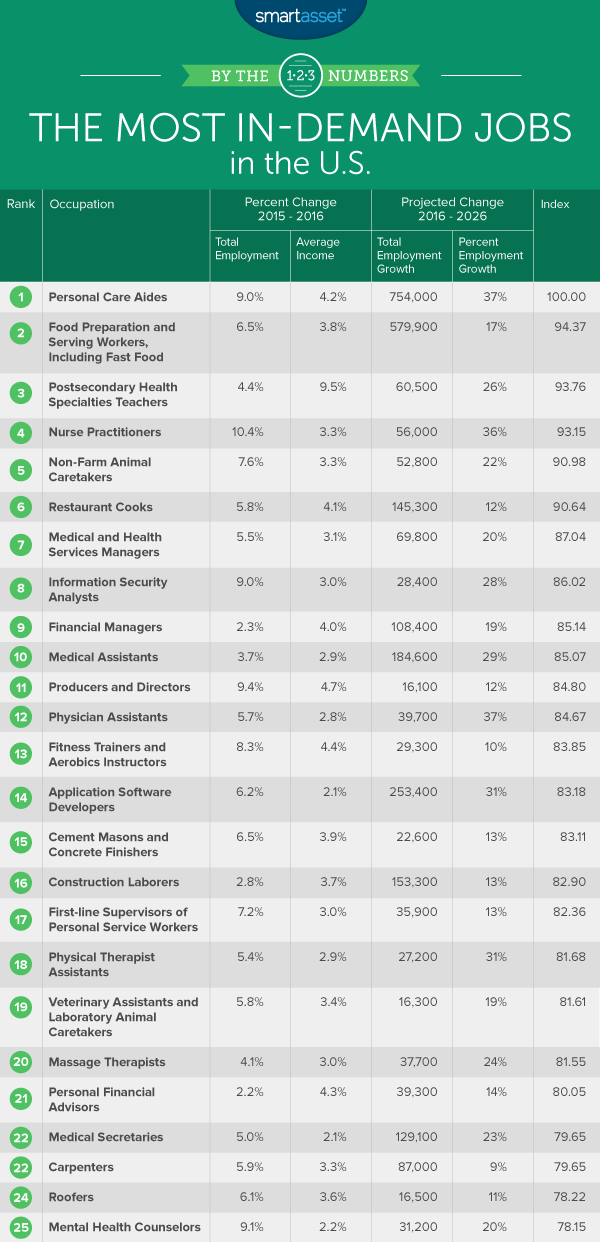
The job market can change quickly. The decline in manufacturing jobs was a focus during the 2016 presidential election and the BLS projects some jobs like data entry keyers will be in serious decline by 2026. To stay ahead of these trends, and to make sure your savings account never runs dry, it’s a good idea to know what jobs are most in demand. Below we rank those jobs looking at which have the best short- and long-term prospects.
In order to determine the most in-demand jobs, SmartAsset looked at data on four metrics. We looked at growth in employment from 2015 – 2016, percent change in average incomes from 2015 – 2016, expected growth from 2016 – 2026 and expected percent change from 2016 – 2026. Check out our data and methodology below to see where we got our data and how we put it together.
Key Findings
- Service jobs – If the BLS projections are correct, more and more people will be employed in the service industry in the coming years. In fact, four of the 10 most in-demand jobs are in the service industry.
- Medicine dominates – Due to an ageing population, demand for health care providers of all sorts are in demand. Our top 10 has five different medical professions in it. Personal care aides, ranked first overall, has no education requirements, and to be a health service manager you need a bachelor’s degree.
- Food preparation – Working in food preparation will continue to be a popular job in the future. Between restaurant cooks and fast food preparation workers the BLS projects 725,200 new jobs. Unfortunately these jobs do not to pay too well. Fast food preparation and serving workers earned $20,460 on average in 2016 and restaurant cooks earned $25,400.
- Wide range of outcomes – Of the top 10 in-demand jobs, the average pay for five was over $96,000 in 2016. For the other five, it was under $32,850.

1. Personal Care Aides
The Bureau of Labor Statistics expects there to be 754,000 more personal care aides in 2026 than there were in 2016. The increase in demand for personal care aides is directly related to the growth in the elderly population. The baby boomer generation in particular will be drive a lot of demand for personal care aides.
Short-term job prospects for this occupation look good. From 2015-2016, the number of personal care aides grew by 9%. Personal care aides may want to take special care to plan their retirement. The average personal care aide in 2016 earned only $22,710.
2. Food Preparation and Serving Workers, Including Fast Food
The Bureau of Labor Statistics estimates that the number of people employed in this occupation will grow by 16.8%, or 579,900, from 2016-2026. This occupation ranks 39th and 2nd for those two metrics, respectively.
While the average worker in this profession got a 3.8% raise from 2015 – 2016, it’s not the best long-term career option. The average person employed in this occupation earned less than $21,000 in 2016.
3. Postsecondary Health Specialties Teachers
People who work as postsecondary health specialties teachers instruct others in fields such as dentistry, medicine, therapy or veterinary medicine, among other disciplines. This job is in white-hot demand recently. From 2015 to 2016, the average postsecondary health specialties teachers saw their pay increase by almost 10%.
The BLS expects this occupation to be a winner long term, as well. It projects employment in this occupation will increase 25% by 2026.
4. Nurse Practitioners
The fourth-most in-demand job is nurse practitioner. From 2015 to 2016, the total number of nurse practitioners grew 10.4%, from 136,060 to 150,230.
If you are thinking about becoming a nurse practitioner, you should be aware of the education requirements. You need at least a master’s degree, which could mean racking up student debt. But becoming a nurse practitioner may pay off in the long run. The average nurse practitioner earned $104,610 in 2016.
5. Non-Farm Animal Caretakers
If you like working with animals and don’t want to become a veterinarian, this could be an interesting occupation for you. The BLS expects the number of non-farm animal caretakers to rise by 21.9% from 2016 to 2026. That’s the 20th-fastest rate in our study. From 2015-2016, the number of people employed in this occupation rose 7.6%.
If you are looking to earn a lot of money while working with animals it may be best to go the veterinary route. The average non-farm animal caretaker earned under $25,000 in 2016.
6. Restaurant Cooks
There are a lot of restaurant cooks in the U.S. and their numbers will continue to grow. As of 2016, there were about 1.2 million restaurant cooks in the country and BLS projections estimate that by 2026 there will be 145,000 more. For that metric, restaurant cooks ranks 13th.
Restaurant cooks do not earn too much, but the job also has no educational requirements and requires less than five years of experience. Plus, if you excel in your role as restaurant cook you have the chance of becoming head chef, an occupation which paid almost $48,000 per year, on average in 2016.
7. Medical and Health Services Managers
People in this profession plan, direct and coordinate medical and health services. According to the BLS, this occupation is expected to grow by almost 20% for the same reasons as personal care aides: with more people ageing, the demand for health care services will rise.
One concern for people in this profession might be the relatively slow income growth. From 2015 to 2016, the average health services manager’s income rose by only 3.1%. For that metric it ranked a low 125th.
8. Information Security Analysts
If you’re worried about the slew of data breaches which took place over 2017, you may take some comfort in the fact that the number of information security analysts is growing. This occupation is growing as a response to the increased threat of hackers, according to the BLS.
The BLS estimates the occupation will grow by 28% from 2016 to 2026. That’s the ninth-fastest in our study.
9. Financial Managers
Financial manager takes ninth. This job did not grow much from 2015 to 2016 – only 2.3% – but the BLS expects that number to pick up as the decade rolls along. BLS projections show an estimated increase of 19%, or 108,400 total employed financial managers from 2016 to 2026. Financial managers ranks in the top 30 for both metrics.
10. Medical Assistants
Medical assistant rounds out our top 10. This occupation dominates the long-term metrics. In both total employment growth from 2016 to 2026 and percent change in total employment from 2016 to 2026, this occupation ranks in the top 10.
Unfortunately, workers in this occupation may need to plan carefully for their retirement as this is not a high-paying job. The average medical assistant earned $32,850 in 2016.

Data and Methodology
In order to find the most in-demand jobs, SmartAsset looked at data for 411 occupations. We eliminated occupations with unclear titles like “engineers, all other” and “physicians and surgeons, all other” from our final rankings. We analyzed the occupations in the following four metrics:
- The percent change in average incomes from 2015 to 2016. This is the percent change in mean earnings for an occupation from 2015 to 2016. Data comes from the Bureau of Labor Statistics’ Occupational Employment Statistics for 2016 and 2015.
- The percent change in employment from 2015 to 2016. This is the percent change in the total number of people employed in an occupation from 2015 to 2016. Data comes from the Bureau of Labor Statistics Occupational Employment Statistics for 2016 and 2015.
- The projected total employment change from 2016 to 2026. This is the projected change in the total number of people employed in an occupation from 2016 to 2026. Data comes from the Bureau of Labor Statistics Employment Projections.
- The projected percent change in employment from 2016 to 2026. This is the projected percent change in the number of people employed in an occupation from 2016 to 2026. Data comes from the Bureau of Labor Statistics Employment Projections.
First, we ranked each occupation in each metric. We then found each occupation’s average ranking. Using this average ranking we created our final score. The occupation with the best average ranking received a 100. The city with the worst average score received a 0.
Tips for Making the Most of Your Savings
Most people stick the money they are not investing or saving for retirement into a normal savings account. But not every savings account is the same and different banks offer very different interest rates.
The best saving accounts are places that allow your money to grow as much as possible, this means banks that offer the highest interest rates and no or low fees. Some online banks in particular offer interest rates over 1%, and don’t have minimum deposit requirements or monthly service fees.
But just because there are some great savings account options available, putting money in one should not always be your only priority. Paying off high interest loans, like credit card debt, should come first and then building an emergency fund should be second.
Questions about our study? Contact us at press@smartasset.com
Photo credit: ©iStock.com/kali9